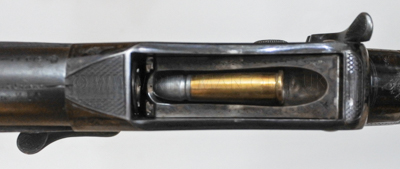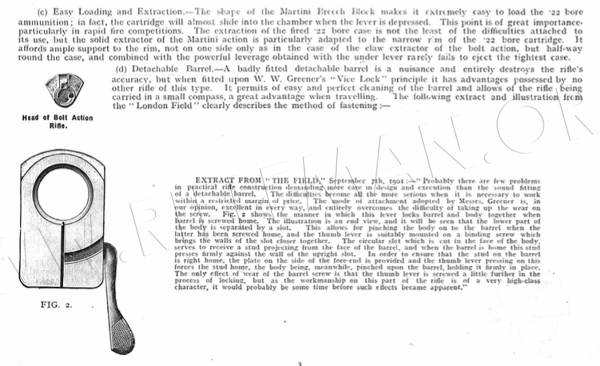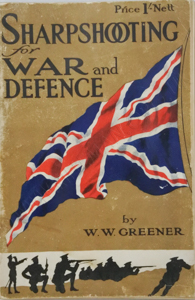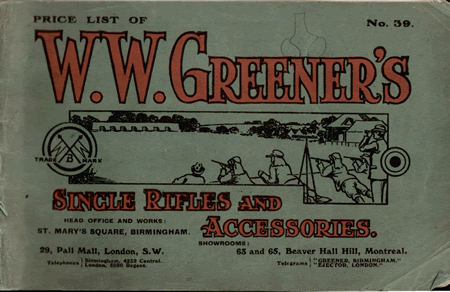W.W. Greener De Luxe .310 calibre
Martini Park Rifle
See also our W.W. Greener's Martini Rifles page
W.W. GREENER was particularly well-known for the highest quality rifles in his wide range of products.
The company's de luxe models were afforded some of the best engraving and chequering finishes available anywhere.
The here illustrated example of the type marketed pre-WW1, and exhibits Greener's fine work to a 'tee'. It is one of just 1,204 small-bore rifles produced by the company in 1902, according to Greener's limited listings of serial numbers available HERE.
Drag horizontally to rotate subject - Click to zoom and drag to pan - Full screen viewing from expansion arrows.
The company's 1914 catalogue listed these products, showing the rifle in its available guises.
Prices were shown in pounds, shillings and pence, (a shilling equating to 5 post-1971 decimal pence).
The price of one pound and one shilling was usually expressed as one 'guinea'.
E.g. '£4-4s-0d' was spoken as 'four guineas'.
The base model with open sights cost four guineas, and an additional one-pound and one shilling
would purchase the 'Grade M 84" with an orthoptic folding rear sight (model S741 at one guinea)
and combination fore-sight (model S710 at four shillings).
The windage adjustable version of the barrel tangent rear-sight (model S740) cost 7/6d.

The 'small-action' martini rifles usually had removable action locks
for ease of inspection and cleaning, and repair.
Greener developed his own 'take-down' system
to allow carriage of his rifles in shorter shotgun-style cases.
Here, a close-up shot of the contemporary Greener case label
 .
.

Below: the action and barrel separated.
Hover to Zoom
The catalogue gave instructions on the correct method for barrel and action removal.

The text is here duplicated for clarity.
HOW TO OPERATE THE GREENER DETACHABLE BARREL.
1st, Drop CRAMP leverA as shown in sketch.
2nd. Drop MAIN lever B as shown in sketch
Taking care to press this lever as far as it will go for the reason explained below.
Note: - It is impossible to unscrew the Barrel from the action to dismount it unless the Extractor C is lifted away clear.
(c) Detachable Lockwork. - All the Greener "Miniature Club" type of rifles. including "The Ladies Model", are now fitted with what is known as the Mark III detachable action. Its special features are the provision of an easily detached lock without the aid of tools for cleaning or repairs. To strip the lock one has only to screw out the thumb lever on the left side of the action - which also serves to lock the barrel in position - and the whole of the lock mechanism can then be removed from the action in one piece as illustrated. No force should be used when replacing the lock work, it will slip easily into position if the back stud is carefully fitted into its place.
[Ed: the Park Rifle lock has a lug at the FRONT that requires locating in a slot at the front of the receiver body before the lock can be pushed home at the rear, and the locating thumb screw fitted in place. Certainly no force should be applied, but arranging for the tumbler to engage in the falling block and the extractor to be correctly positioned is not the simplest of activities!]
The hand-engraved company details on the barrel read .....
"WW. GREENER, 68 HAYMARKET LONDON S.W. WORKS. 57 ST. MARY'S SQUARE, BIRMINGHAM'
"AMMUNITION .310"

Below: the original barrel proof mark of '310 12-120'
Note that these .310 rifles are now of obsolete calibre, and no longer required to be licensed.
However, if they are to be shot in such as historic competition, they require both licensing and current proof.

The proof mark relates respectively to the calibre, the powder charge (12 grains), and the bullet weight (120 grains).
The .310-inch cartridge was itself designed by William Greener ca. 1900, specifically for use with the Martini Cadet rifle.
The muzzle velocity was a comparatively light recoiling 1200 to 1400 feet per second - just about supersonic.
The cartridge was ideal for the military training of young would-be recruits,
and fared remarkably well in the field of deer stalking and culling,
while probably over-preparing a rabbit or rook for the pot.
In modern historic competition, carefully loaded ammunition has proved notably accurate.
Rounds originally used militarily were fully jacketed,
although sporting rounds with lead and hollow points were commercially available.
For ease, economy and reduced bore wear most rifles are today shot with all-lead cast bullets.
The rifle's serial number is only shown fully on the trigger guard and front of the receiver body.
Other components are stamped with just the last three or two digits, dependent upon space.

The engraving, machining and finish are superb.
The left photograph below shows the unusual addition to a small-frame martini of a thumb-lever safety catch,
as well as the retaining screw for the action lock.
The right-hand picture shows the barrel clamp locking lever
which needs only a half-turn anti-clockwise to release the barrel (with the under-lever drawn down)
 .
. 
The receiver body is here shown from beneath, with the base of the falling block.
The slot for the trigger tumbler is at its rear centre.
The barrel clamping lever's action across the split in the front of the receiver body is evident.

For size comparison with the .22RF and .297/.230 CF Morris calibre Martini rifles,
the .310 cartridge is lain in the loading chute of the falling block.

Greener's own description of the take-down arrangement is given in the catalogue.

Again, the details are here duplicated for clarity.
(d) Detachable Barrel. - A badly fitted detachable barrel is a nuisance and entirely destroys the rifle's accuracy, but when fitted upon W.W. Greener's "Vice Lock" principle it has advantages possessed by no other rifle of this type. It permits of easy and perfect cleaning of the barrel and allows of the rifle being carried in a small compass, a great advantage when travelling. The following extract and illustration from the "London Field" clearly describes the method of fastening.
EXTRACT FROM "THE FIELD" , September 7th. 1901 :- "Probably there are few problems in practical rifle construction demanding more care in design and execution than the sound fitting of a detachable barrel. The difficulty becomes even more serious when it is necessary to work within a restricted margin of price. The mode of attachment adopted by Messrs. Greener is, in our opinion, excellent in every way, and entirely overcomes the difficulty of taking up the wear on the screw. Fig 2. shows the manner in which this lever locks barrel and body together when the barrel is screwed home. The illustration is an end view, and it will be seen that the lower part of the body is separated by a slot. This allows for pinching the body on to the barrel when the latter has been screwed home, and the thumb lever is suitably mounted on a binding screw which brings the walls of the slot closer together. The circular slot which is cut in the face of the body serves to receive a stud projecting from the face of the barrel, and when the barrel is home this stud presses firmly against the wall of the upright slot. In order to ensure that the stud on the barrel is right home, the plate on the side of the fore-end is provided and the thumb lever pressing on this forces the stud home, the body being, meanwhile, pinched upon the barrel, holding it firmly in place. The only effect of wear of the barrel screw is that the thumb lever is screwed a little further in the process of locking, but as the workmanship on this part of the rifle is of a very high-class character, it would probably be some time before such effect become apparent.
[Ed: the latter point is evidently true. It is apparent that this near one-hundred-and-ten year old rifle has been comparatively well, although carefully, used in its time; but the engagement of barrel to body remains perfectly tight and secure.]
The front of the action body with the clamping slot is shown below.

The rifle was originally found fitted with Greener's own long-range target rear-sight.
This is shown in the catalogue as item no. R1035.
The caption reads .....
'Vernier scale screw adjusting back sight, platina lined,
used in conjunction with foresight no.1001 for long-range match shooting.'
 ........................
........................ 
The subject rifle uses that particular removable fore-sight, that is fitted inverted under the barrel
and, rather like many fore-sight protectors,
is run past the standard open fore-sight block, rotated to its vertical position,
and pushed forward to locate on the rear of the fixed fore-sight block.
The sight and its catalogue entry are shown below.
The catalogue illustrates the sight fitted with a very useful optional spirit level.
There is nothing new in target shooting!
It is described as a "combination detachable spirit level and wind-gauge Match sight with bead".
It is priced at three guineas, with an optional aperture disc (presumably a ring fore-sight post element)
available for a further seven shillings and six-pence.
 ................
................ 
The barrel's tangent sight is Greener's model S740, also at 7/6d.
This had by then been available for some years,
and was actually illustrated in Greener's 1900 book "Sharp Shooting for Sport & War",
of which there is further mention later on this page.
 ..................
.................. 
Additional sights were shown earlier on this page in the gun case
amongst the accessories such as a cleaning rod, patches and ammunition.
The rifle's stock wrist, just behind the receiver body, has a pair of lateral screw holes
in the wood, where another rear-sight was once fitted.
Close inspection suggests that this sight was one of those originally fitted to a standard de luxe rifle.
This would have been the model S751 shown below with its advertisement.
The holes in the butt wrist and the curvature of the mount are a perfect match for this sight
 ...........
........... 
Greener advertised his sights in the National Rifle Association journals of 1911.

Another useful contemporary sporting accessory for these rifles was an A.G. Parker product, their 'optical fore-sight'.
This product is descibed on a separate page - see the Optical Sight Set
 ...........
...........
We illustrate the 1914 catalogue for W.W. Greener, in which these rifles are represented.
This catalogue is, at its earliest, dated to Autumn 1914, and is unlikely to be much later,
when the company's efforts and production would have been put over to wartime requirements.
Had the catalogue been printed post the First World War it would probably have been much less comprehensive.
Click image to view
(See also our W.W. Greener's Martini Rifles page
Below: a catalogue photograph of the Greener Birmingham Works, at St. Mary's Square.
The caption immodestly describes the works as the largest in Great Britain.

Greener's three addresses are shown on a page in his 1914 book.
As well as the St. Mary's Square, Birmingham Works,
there was the main retailing outlet 68, Haymarket, London,
and another at 19, Paragon Street, Hull.
The latter address was perhaps instrumental in the naming of the Paragon guns.

William Greener was nothing if not a patriot.
Quite apart from his famous and longstanding tome "The Gun and its Development" he wrote three smaller books.
Two of these were related to wars in which Great Britain became involved,
and extolled the virtue of rifle shooting for the protection of the Nation.
His first, "Sharp Shooting for Sport & War", was published in 1900
when the Boer Wars with South Africa were the crises of the time.
Five years later, when a degree of peace had come between conflicts,
his attention was diverted to the promotion of his commercial products.
In 1905 he published "The British Miniature Rifle",
which is a veritable fountain of information for current researchers and collectors.
This was at a time when the other major gunmaking patriot and author Luke R. Tippins
was authoring similar publications.
With the approach and onset of the First World War in 1914, Greener penned another book
"Sharpshooting for War & Defence" further recommending practice in the use of the rifle,
and offering yet more advice on how to become a well-trained and effective rifleman.
The covers of these three books are illustrated below;
Left: 1900; centre 1905 and right 1914.
 .......
.......  .......
....... 
As a finale to this page, we present an excerpt from his 1914 book.
This is the section that briefly covered the 'Miniature Rifle'.
It is in the form of a searchable flip-page facsimile, which may take a few moments to display.
N.B. The search magnifier may need to be clicked twice.
What actually is a "Miniature Rifle"
See also W.W. Greener's Martini Rifles including the Queen's Cup
as well as the Greener Martini Miniature Club and Cadet rifles
the Greener GPO converted Martini
and Greener's and other fencing muskets
Please also note our BIBLIOGRAPHY


